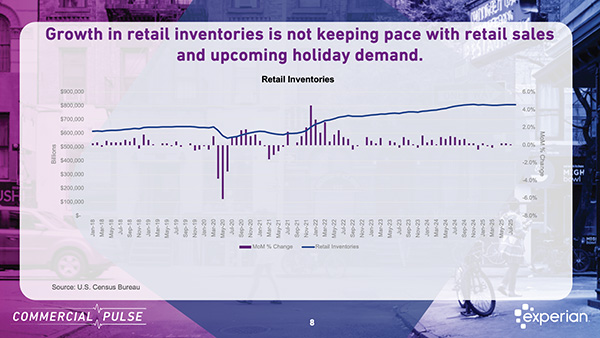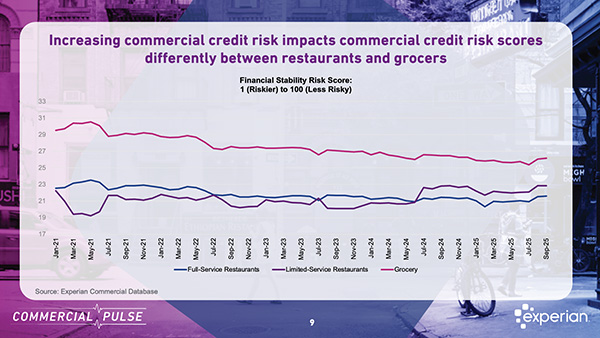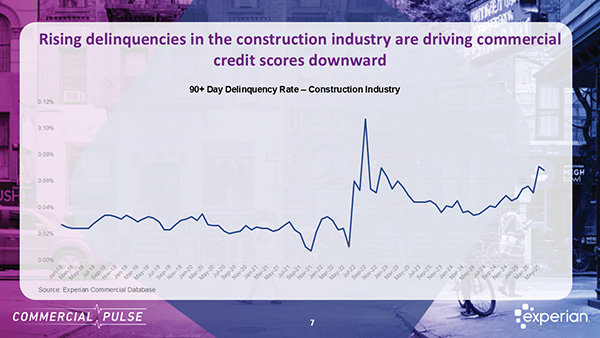At A Glance
Delinquencies are rising in the logistics sector. This article explores credit risk trends in transportation and warehousing from Experian’s latest insights.As the U.S. economy continues to recalibrate post-pandemic, the transportation and warehousing segments of the logistics sector are signaling caution. While the broader logistics industry has remained in expansion mode, Experian’s latest Commercial Pulse Report reveals that delinquencies are rising—an early warning of growing risk in two of the economy’s most critical subsectors.
Watch the Commercial Pulse Update
Below, we explore how sector-specific credit trends, employment data, and market activity are evolving, and what they may mean for lenders, suppliers, and investors as we head into the final quarter of 2025.
Slowing Growth in the Logistics Sector
The U.S. logistics sector has experienced remarkable growth over the past decade. Between 2013 and 2023, the number of private logistics businesses doubled, peaking in Q4 2023. Since then, business formation has slowed, and for the first time in years, the number of logistics firms has declined—down by 2%.
Employment trends echo this slowdown. Between April 2020 and July 2022, logistics employment rose 25%. Since then, growth has nearly stalled, increasing by just 1.5%. This softening suggests that many logistics firms are adjusting operations and tightening resources in response to shifting demand and rising costs.
Inventory Pressure and LMI Performance
The Logistics Managers Index (LMI)—a diffusion index that tracks key logistics components like transportation, inventory, and warehousing—fell to 57.4 in September 2025. While still in expansion territory (above 50), it’s the lowest reading since March, indicating cooling momentum across the sector.
Inventory levels remain elevated, but rising inventory costs are beginning to pressure future planning. Since December 2023, inventory costs have steadily increased. Retailers typically adjust inventory levels in response to cost changes with a lag, meaning elevated costs could soon lead to leaner inventories—potentially pulling the LMI down further.
Warehousing utilization is also up, and prices have followed. As available space tightens, warehousing costs are rising, adding to the financial strain for logistics firms. This dynamic has the potential to further compress margins and reduce cash flow flexibility for small- and mid-sized operators.
Transportation Trends: Warning Signs Ahead
Transportation—a cornerstone of the logistics network—is showing early signs of contraction. Transportation utilization fell to 50 in September, right on the edge of entering contraction territory. A decline in utilization typically leads to an increase in transportation capacity, as seen in the most recent data, and declining transportation prices.
Lower prices benefit shippers but challenge carriers, particularly smaller players who operate on tighter margins. With costs rising across warehousing and inventory management, declining transportation revenue could tip the balance for many firms, increasing financial vulnerability.
Credit Demand and Originations Continue to Fall
Experian’s credit data paints a picture of declining demand for commercial credit within logistics. Since the pandemic, the percentage of monthly credit originations in the logistics sector has dropped sharply—from 4.5% to just 0.5%. This suggests businesses are becoming more cautious about taking on new debt.
Interestingly, while originations have declined, outstanding balances have remained steady, and in warehousing, they’ve even exceeded pre-pandemic levels. This could reflect longer repayment cycles, reduced cash flow, or delayed investment decisions—all potential risk flags.
Trucking: Dominant but at Risk
Within the logistics sector, trucking remains dominant, accounting for 82% of all open commercial credit trades. This segment relies heavily on commercial cards, which now make up 79% of open credit trades. These cards are often the first credit instrument used by new businesses, making them a leading indicator of early-stage credit performance.
While the prevalence of commercial cards reflects flexibility, it also comes with limitations. Lower credit limits and higher interest rates can create challenges during periods of cash flow strain, especially for operators managing fuel, maintenance, and payroll costs.
Rising Delinquencies and Declining Credit Scores
Perhaps the most concerning trend in this month’s report is the increase in late-stage delinquencies within the logistics sector. Since mid-2021, delinquencies have shifted from early-stage (1–30 days past due) to more serious late-stage (91+ days past due) balances.
In August 2025, 1–30 day delinquencies accounted for just 20 basis points of total past-due balances, while late-stage delinquencies accounted for 47 basis points—nearly double the 2019 average. As these deeper delinquencies mount, average commercial credit scores are declining, despite slight improvements earlier in 2024.
This trend is especially critical for lenders and suppliers. A shift toward aged receivables can signal liquidity challenges, operational inefficiencies, or broader sector stress. For businesses operating on thin margins or in highly competitive sub-industries, rising delinquencies could signal a tipping point.
What to Watch Going Forward
The outlook for the logistics sector remains mixed. While growth hasn’t reversed completely, the combination of rising costs, falling credit originations, and growing delinquencies indicates rising risk, particularly in transportation and warehousing.
Stakeholders should closely monitor:
- Changes in LMI component trends
- Late-stage delinquency rates across business segments
- Shifts in credit utilization and origination patterns
- Warehouse pricing and utilization metrics
These signals can offer early insight into shifting risk exposure across commercial portfolios.
Explore More Insights
Experian continues to provide actionable data to help businesses, lenders, and policymakers navigate uncertainty. To access the full Commercial Pulse Report and explore more insights on small business credit and sector-specific performance:
- ✔ Visit our Commercial Insights Hub for in-depth reports and expert analysis.
- ✔ Subscribe to our YouTube channel for regular updates on small business trends.
- ✔ Connect with your Experian account team to explore how data-driven insights can help your business grow.



